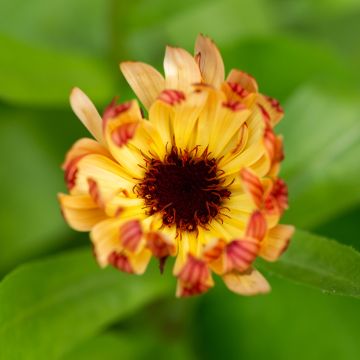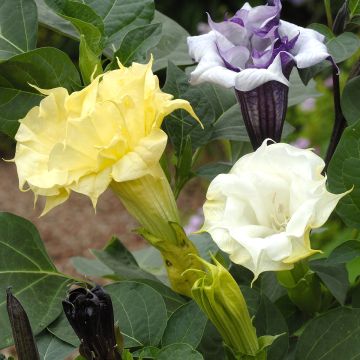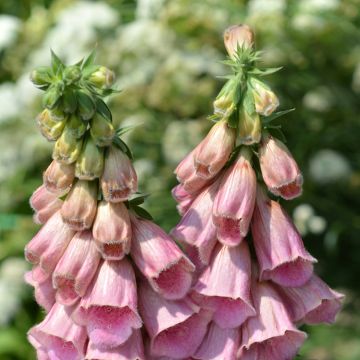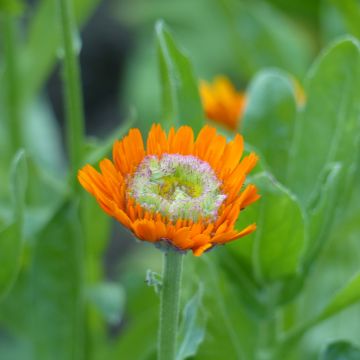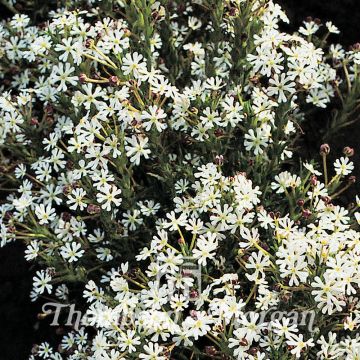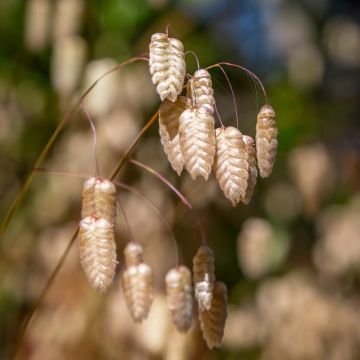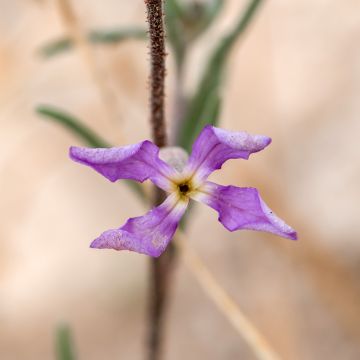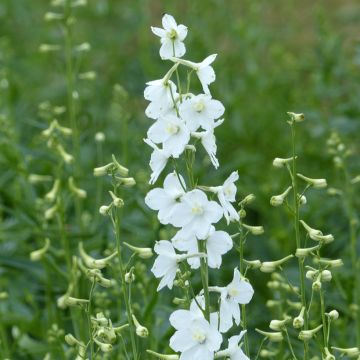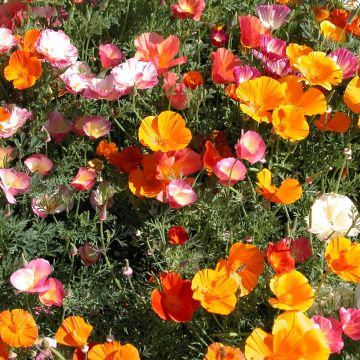

Mimulus x Hybridus Maximus Mixed
Mimulus hybridus Maximus Mixed
Mimulus x hybridus Maximus Mixed
Monkey flower, Musk flower
This item cannot be shipped to the selected country
Dispatch by letter from €3.90
More information
Schedule delivery date,
and select date in basket
This plant carries a 6 months recovery warranty
More information
We guarantee the quality of our plants for a full growing cycle, and will replace at our expense any plant that fails to recover under normal climatic and planting conditions.
Seed-only orders are dispatched by sealed envelope. The delivery charge for seed-only orders is €3.90.
Does this plant fit my garden?
Set up your Plantfit profile →
Description
Mimulus Maximus Mixed is a selection that produces flowers like you've never seen before! It's a giant variety in a wide range of colours. Cultivated as an annual, it makes an excellent ground cover plant whose unique flowering can be admired from June to September.
Mimulus is a short-lived perennial cultivated as an annual in our latitudes. It is also called mimule, monkey flower, or musk flower due to the musky smell of certain varieties. It belongs to the Phrymaceae family and is native to Mexico. This spreading and floriferous beauty measures 25cm (10in) in height and width.
Its foliage is dark green to grey-green and is ovate with slightly indented edges. The mimulus flower has five fused petals, enclosed in a long calyx forming a trumpet ending with two lips resembling a smiling mask and sticking out its tongue. Some people see the figure of a monkey in it, hence the name monkey flower. The Maximus Mixed collection of seeds offers giant flowers, which are on average four times larger than most mimulus flowers. They measure over 10cm (4in) in circumference and come in a wide range of colours: white, yellow, vibrant orange, burgundy red, and Bordeaux red, as well as bicolour and variegated varieties.
Mimulus appreciates light shade as well as moist to wet humus-rich soils. Avoid placing it in direct hot sunlight as it would not tolerate it. Give it a prominent place in border plantings alongside Mimulus luteus in an exotic garden, or on the edge of a pond where it will find all the moisture it needs. It is not very hardy and becomes fragile below -5°C (23°F). To keep it for several summers, plant it in pots where it can thrive and spend the winter in warmth.
Mimulus are known to absorb sodium chloride from the soil, storing and concentrating it in their leaves and stems, so much so that Native Americans used them as a salt substitute for their meals. The entire plant is edible and retains its salty taste even when cooked. The foliage was also used as a poultice to soothe the pain of minor burns.
Report an error about the product description
Flowering
Foliage
Plant habit
Botanical data
Mimulus
x hybridus
Maximus Mixed
Scrophulariaceae
Monkey flower, Musk flower
Cultivar or hybrid
Other Thompson and Morgan seeds
Planting and care
Sow your seeds in trays from March to May on the surface of good sowing compost. Keep the substrate moist without excess at room temperature between 20 and 30°C (68 to 86°F). Do not exclude light as it is needed in the germination process. You will have to wait 10 to 21 days before the young shoots appear. Gradually acclimatise your seedlings to cooler temperatures. Once they are strong enough to handle and there is no risk of frost, transplant them outside into humus-rich and well-worked soil, making sure to space each plant 25 to 30cm (10 to 12in) apart. Removing faded flowers promotes flowering again.
Sowing period
Intended location
-
, onOrder confirmed
Reply from on Promesse de fleurs
Flower seeds
Haven't found what you were looking for?
Hardiness is the lowest winter temperature a plant can endure without suffering serious damage or even dying. However, hardiness is affected by location (a sheltered area, such as a patio), protection (winter cover) and soil type (hardiness is improved by well-drained soil).

Photo Sharing Terms & Conditions
In order to encourage gardeners to interact and share their experiences, Promesse de fleurs offers various media enabling content to be uploaded onto its Site - in particular via the ‘Photo sharing’ module.
The User agrees to refrain from:
- Posting any content that is illegal, prejudicial, insulting, racist, inciteful to hatred, revisionist, contrary to public decency, that infringes on privacy or on the privacy rights of third parties, in particular the publicity rights of persons and goods, intellectual property rights, or the right to privacy.
- Submitting content on behalf of a third party;
- Impersonate the identity of a third party and/or publish any personal information about a third party;
In general, the User undertakes to refrain from any unethical behaviour.
All Content (in particular text, comments, files, images, photos, videos, creative works, etc.), which may be subject to property or intellectual property rights, image or other private rights, shall remain the property of the User, subject to the limited rights granted by the terms of the licence granted by Promesse de fleurs as stated below. Users are at liberty to publish or not to publish such Content on the Site, notably via the ‘Photo Sharing’ facility, and accept that this Content shall be made public and freely accessible, notably on the Internet.
Users further acknowledge, undertake to have ,and guarantee that they hold all necessary rights and permissions to publish such material on the Site, in particular with regard to the legislation in force pertaining to any privacy, property, intellectual property, image, or contractual rights, or rights of any other nature. By publishing such Content on the Site, Users acknowledge accepting full liability as publishers of the Content within the meaning of the law, and grant Promesse de fleurs, free of charge, an inclusive, worldwide licence for the said Content for the entire duration of its publication, including all reproduction, representation, up/downloading, displaying, performing, transmission, and storage rights.
Users also grant permission for their name to be linked to the Content and accept that this link may not always be made available.
By engaging in posting material, Users consent to their Content becoming automatically accessible on the Internet, in particular on other sites and/or blogs and/or web pages of the Promesse de fleurs site, including in particular social pages and the Promesse de fleurs catalogue.
Users may secure the removal of entrusted content free of charge by issuing a simple request via our contact form.
The flowering period indicated on our website applies to countries and regions located in USDA zone 8 (France, the United Kingdom, Ireland, the Netherlands, etc.)
It will vary according to where you live:
- In zones 9 to 10 (Italy, Spain, Greece, etc.), flowering will occur about 2 to 4 weeks earlier.
- In zones 6 to 7 (Germany, Poland, Slovenia, and lower mountainous regions), flowering will be delayed by 2 to 3 weeks.
- In zone 5 (Central Europe, Scandinavia), blooming will be delayed by 3 to 5 weeks.
In temperate climates, pruning of spring-flowering shrubs (forsythia, spireas, etc.) should be done just after flowering.
Pruning of summer-flowering shrubs (Indian Lilac, Perovskia, etc.) can be done in winter or spring.
In cold regions as well as with frost-sensitive plants, avoid pruning too early when severe frosts may still occur.
The planting period indicated on our website applies to countries and regions located in USDA zone 8 (France, United Kingdom, Ireland, Netherlands).
It will vary according to where you live:
- In Mediterranean zones (Marseille, Madrid, Milan, etc.), autumn and winter are the best planting periods.
- In continental zones (Strasbourg, Munich, Vienna, etc.), delay planting by 2 to 3 weeks in spring and bring it forward by 2 to 4 weeks in autumn.
- In mountainous regions (the Alps, Pyrenees, Carpathians, etc.), it is best to plant in late spring (May-June) or late summer (August-September).
The harvesting period indicated on our website applies to countries and regions in USDA zone 8 (France, England, Ireland, the Netherlands).
In colder areas (Scandinavia, Poland, Austria...) fruit and vegetable harvests are likely to be delayed by 3-4 weeks.
In warmer areas (Italy, Spain, Greece, etc.), harvesting will probably take place earlier, depending on weather conditions.
The sowing periods indicated on our website apply to countries and regions within USDA Zone 8 (France, UK, Ireland, Netherlands).
In colder areas (Scandinavia, Poland, Austria...), delay any outdoor sowing by 3-4 weeks, or sow under glass.
In warmer climes (Italy, Spain, Greece, etc.), bring outdoor sowing forward by a few weeks.

































